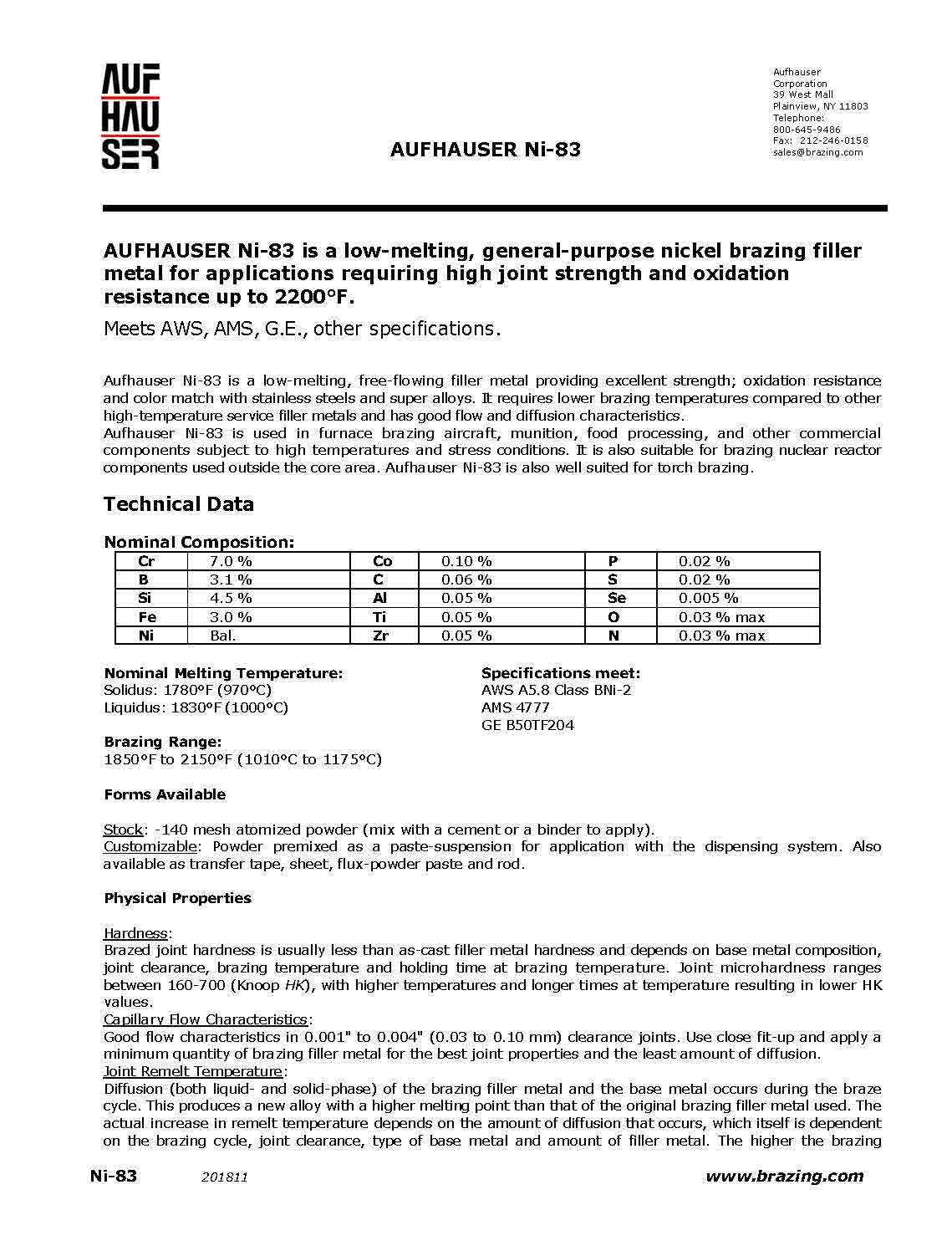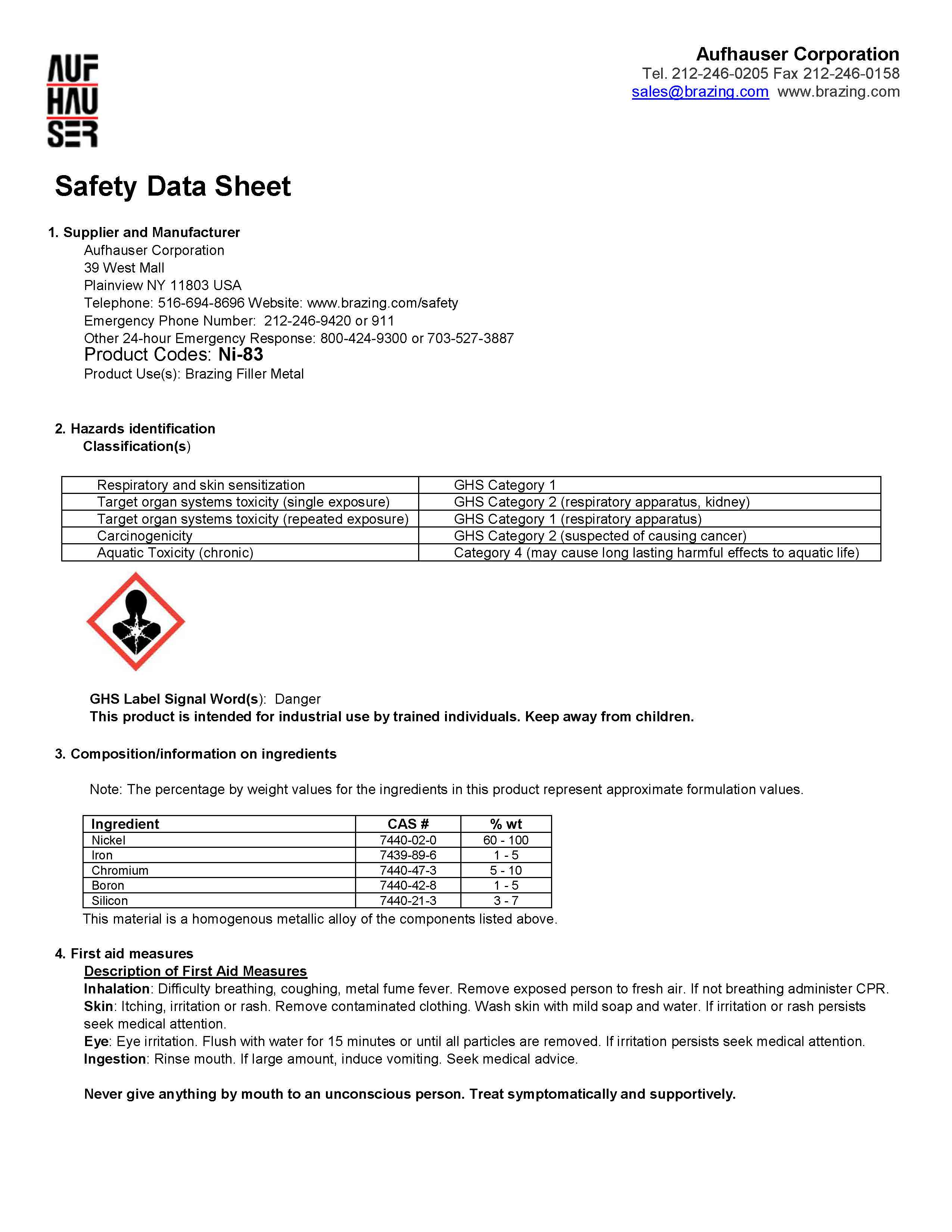Nickel Brazing Alloy Ni-83
Nominal Chemical
Composition
REFERENCES
Nickel Brazing Alloy ProceduresINTRODUCTION
Aufhauser Ni-83 is a low-melting, free-flowing filler metal providing excellent strength; oxidation resistance and color match with stainless steels and super alloys. It requires lower brazing temperatures compared to other high-temperature service filler metals and has good flow and diffusion characteristics. Aufhauser Ni-83 is used in furnace brazing aircraft, munition, food processing, and other commercial components subject to high temperatures and stress conditions. It is also suitable for brazing nuclear reactor components used outside the core area. Aufhauser Ni-83 is also well suited for torch brazing.
Chemical Composition
| Ni | Cr | B | Si | Fe | Co | C | Al | Ti | Zr | P | S | Se | O | N |
|---|---|---|---|---|---|---|---|---|---|---|---|---|---|---|
| Remainder | 7.0 | 3.1 | 4.5 | 3.0 | 0.10 | 0.06 | 0.05 | 0.05 | 0.05 | 0.02 | 0.02 | 0.005 | 0.03* | 0.03* |
* maximum
PHYSICAL and MECHANICAL PROPERTIES
| Liquidus | 1830°F (1000°C) |
| Solidus | 1780°F (970°C) |
| Recommended Brazing Temperature | 1850-2150°F (1010-1175°C) |
| Joint microhardness | 160-170 Knoop (HK) |
| Oxidation resistance | Excellent up to 1800°F (980°C) |
Hardness: Brazed joint hardness is usually less than as-cast filler metal hardness and depends on base metal composition, joint clearance, brazing temperature and holding time at brazing temperature. Joint microhardness ranges between 160-700 (Knoop HK), with higher temperatures and longer times at temperature resulting in lower HK values.
Capillary Flow Characteristics: Good flow characteristics in 0.001" to 0.004" (0.03 to 0.10 mm) clearance joints. Use close fit-up and apply a minimum quantity of brazing filler metal for the best joint properties and the least amount of diffusion.
Joint Remelt Temperature: Diffusion (both liquid- and solid-phase) of the brazing filler metal and the base metal occurs during the braze cycle. This produces a new alloy with a higher melting point than that of the original brazing filler metal used. The actual increase in remelt temperature depends on the amount of diffusion that occurs, which itself is dependent on the brazing cycle, joint clearance, type of base metal and amount of filler metal. The higher the brazing temperature and/or longer time at brazing heat, and the narrower the joint clearance, then the higher the resulting remelt temperature, which can reach in excess of 2500°F (1370°C).
Joint Strength and Ductility: On properly diffused, brazed austenitic stainless steel and most non-hardenable base metals, joint strength will be higher than base metal yield at room and elevated temperatures. Ductility will be sufficient to withstand mechanical and thermal fatigue stress. On hardenable base metals, joint strength is widely variable depending on base metal composition and heat treatment, joint design and brazing parameters. Testing of a specific joint design is often necessary to establish joint strength. The most reliable tests for design purposes are stress rupture or simulated service tests. Any brazed lap-joint design should use an overlap of 3T-4T for optimal results (T - thickness of the thinner of the two metals comprising the lap joint). The procedure for shear-strength testing of brazed joints in accordance with American Welding Society Specification ANSI/AWS C3.2 is recommended for design data, quality control or evaluating brazing parameters.
Oxidation Resistance: Excellent through 1800°F (9807°C). Above this temperature, oxidation increases as the temperature increases. (Tests were conducted on T-specimens of alloy 600 (UNS N06600) exposed 500 hours in still air. No fillet deterioration was noted.)
Joint Corrosion Resistance: Proven satisfactory in NaK and high-temperature water media. Corrosion resistance is also good in many other corrosive media, depending upon base metal and brazing cycle. In critical applications, specific tests should be conducted. Corrosion resistance varies with the media involved.
SPECIFICATIONS MEET OR EXCEED |
| AWS A5.8 BNi-2 |
| AMS 4777 |
| GE B50TF204 |
STANDARD SIZES AND FORMS
| Powder, paste, flux-powder paste |
| Foil, preforms, transfer tape |
HOW TO BRAZE
Aufhauser Ni-83 filler metals are manufactured in powdered form. They can be mixed with a binder or purchased as a premixed paste for application with a syringe or air-powered applicator. The filler metals can also be mixed with cement, a liquid plastic binder, and applied as slurry by brush, eyedropper, or other appropriate means. In addition, they can be sprayed using spray system. Allow binder to dry before heating. Furnace Brazing: Temperature range is 1850-2150°F (1010-1175°C). For maximum flow, strength and joint ductility braze at the high end of the range. For minimum diffusion and solution, braze at the low end of the range; heat and cool the assembly as fast as possible without producing distortion. Vacuum of 10-3 Torr or lower, or atmospheres of pure dry hydrogen, dry hydrogen/argon blends, argon, or other inert gases (dew point -60°F/-50°C or drier) are recommended. These protective atmospheres promote excellent wetting and good diffusion of the filler metal into the base metal. Torch Brazing. Induction Heating. Flame Heating: These methods require the use of flux for protection against oxide formation. Flux or flux-powder paste must be allowed to dry before brazing. Induction heating may be performed without flux if a suitable atmosphere is provided around the parts. With proper training and experience, it is possible to braze using TIG non-consumable electrode (as a heating source) in inert gas atmospheres.
EXAMPLE OF USE
Stainless steel piston used in commercial milk packaging equipment is an assembly of four pre-machined components, brazed with Aufhauser Ni-83. The application requires tight, well-diffused, high-strength joints with good color match and no filler metal flow onto polished surfaces. Exposed surfaces must be mirror smooth; bacteria tend to accumulate and grow on any rough areas. Furnace brazing with Aufhauser Ni-83 produced clean, strong joints without the distortion and residual stresses characteristic of welding operations. This eliminated the need for post-assembly machining and stress relieving. (The fillets may be polished to achieve an even smoother, brighter surface.) Batch processing of the brazed pistons further reduced assembly costs versus one-at-a-time welding operations.


